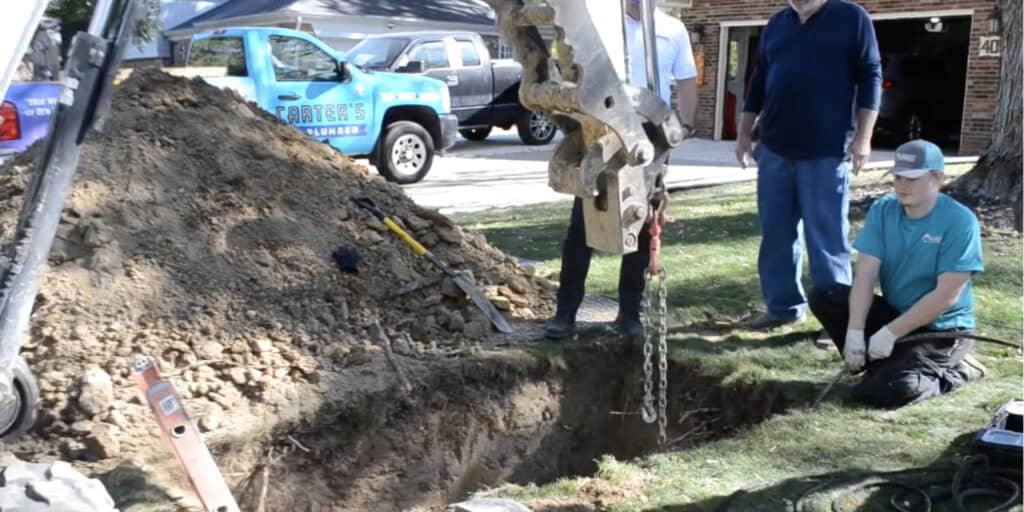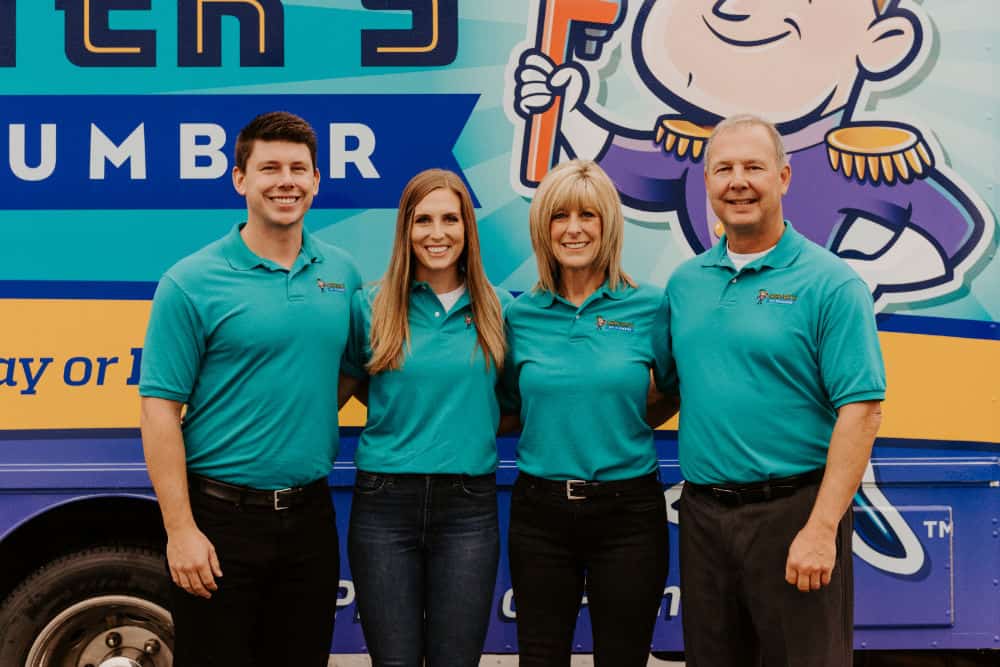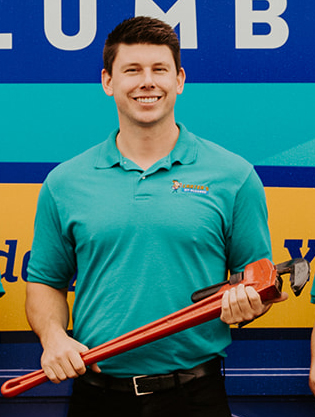Table of Contents
(2025 Update) Most residential trenchless sewer line replacement projects fall between $4,000 and $20,000.
If you’ve been told your sewer line is damaged or beyond repair, you’re probably researching the best way forward. For many homeowners, trenchless sewer line replacement is an appealing alternative to traditional excavation. It’s faster, less disruptive, and in many cases, more cost-effective over the long term.
But how much does trenchless sewer line replacement cost? And is it the right choice for your home? In this guide, we’ll break down the costs, the factors that affect pricing, how it compares to traditional replacement, and why choosing an Indianapolis trenchless sewer repair company with proven expertise can make all the difference.

What Are Trenchless Sewer Line Repairs?
Trenchless sewer repairs or replacement allows plumbers to replace or rehabilitate your existing sewer line without digging a massive trench through your yard. Instead, the process uses small access points at the beginning and end of the line, along with specialized technology, to install a new pipe or liner.
There are two main trenchless methods:
- Cured-in-place pipe lining (CIPP) – A resin-saturated liner is inserted into the existing pipe, inflated, and cured to create a seamless, joint-free new interior wall.
- Pipe bursting – A bursting head breaks apart the old pipe while simultaneously pulling in a new, high-density polyethylene (HDPE) or PVC pipe.
Both methods can typically last for multiple decades when installed correctly.
The Average Costs of Trenchless Sewer Line Replacement
The price of trenchless sewer line replacement isn’t one-size-fits-all. Several factors influence the final bill, from your location and soil conditions to the method used and the condition of your existing pipes. Still, it helps to understand what most homeowners typically pay so you can budget realistically.
National averages for trenchless sewer replacement:
- Most residential projects fall between $4,000 and $20,000.
- The national per-foot average ranges from $80 to $250.
In the Indianapolis area, Carter’s My Plumber sees more specific ranges:
- CIPP (Cured-in-Place Pipe) Lining: $100 to $200 per foot.
- Pipe Bursting: $80 to $180 per foot.
For a typical 50-foot residential sewer line, the total project cost is usually $5,000–$12,000, assuming average conditions. These figures typically include:
- Labor costs for skilled trenchless specialists.
- High-quality materials (epoxy liners or new PVC).
- Standard city permitting and inspection fees.
When costs rise above average
While the ranges above cover most projects, some jobs can exceed them, particularly if:
- The pipe has multiple sharp bends that require additional access points.
- The sewer line has a large diameter (6 inches or more).
- There is severe misalignment or collapse requiring extra preparation.
- Access to the pipe is obstructed by permanent structures, retaining walls, or deep landscaping features.
Even in more complex cases, trenchless replacement often remains more cost-effective than full excavation because you avoid extensive yard restoration, sidewalk replacement, and other collateral expenses that can pile up with traditional methods.
What Factors Affect the Cost?
There are several elements that can push your project toward the higher or lower end of the cost spectrum.
1. Length and Depth of the Sewer Line
- Longer lines require more materials and labor.
- Deeper lines can increase costs if additional access points or shoring are needed.
2. Severity of Pipe Damage
- Small cracks or corrosion may only require lining.
- Collapsed sections or major misalignments may need pipe bursting or partial excavation.
3. Accessibility and Landscaping
- Tight spaces or pipes located under patios, driveways, or mature landscaping may require extra work.
- Trenchless methods minimize disruption but still need space for equipment and staging.
4. Type of Trenchless Technology
- CIPP lining is often slightly more expensive but preserves the original pipe alignment.
- Pipe bursting may be more cost-effective when replacing fully failed pipes.
Cost Comparison: Trenchless vs. Traditional Methods
At first glance, trenchless sewer replacement can seem pricier on a per-foot basis than traditional excavation. It’s true that the initial quote for trenchless work, especially using advanced methods like CIPP lining, may come in higher than a basic “dig and replace” estimate. But when you look at the total project cost, trenchless often wins out.
The hidden cost of traditional excavation
Traditional dig-and-replace methods are labor-intensive and highly invasive. Once the trench is dug and the pipe replaced, you’re left with significant property damage that must be restored. That’s where costs add up–often more than homeowners expect.
Typical restoration expenses can include:
- Full lawn replacement or reseeding: Especially if the line runs the length of the yard.
- Driveway or sidewalk removal and re-pouring: If the pipe runs under concrete.
- Reinstallation of irrigation or fencing: Common in landscaped yards.
- Potential tree removal: And in some cases, stump grinding and root barrier installation to prevent future intrusion.
Depending on your property, these restoration items can add $2,000–$10,000 or more to your total bill.
Why trenchless can be the smarter investment
Trenchless methods, like pipe bursting or CIPP lining, avoid most of these restoration costs. Because only small access points are needed, your yard, driveway, and landscaping remain largely untouched. This means:
- Less time and money spent on post-repair cleanup.
- Faster return to normal household routines.
- Preservation of mature landscaping and hardscaping.
When you add up the numbers, many homeowners find that trenchless work–even with a slightly higher up-front price–ends up being less expensive overall. Plus, you’re avoiding weeks of inconvenience and the risk of hidden restoration issues later.
What Do Costs Vary So Much?
No two sewer line replacements are exactly the same. Here are common reasons your quote might differ from your neighbor’s:
- Permitting and inspection fees: Required in most municipalities, including Indianapolis.
- Local labor rates: Can fluctuate based on demand and contractor expertise.
- Material choice: HDPE, PVC, or epoxy resin liners each have different costs.
- Project complexity: Multiple turns, varying pipe diameters, or partial collapses require additional planning and equipment.
Long-Term Cost Benefits
Trenchless sewer replacement isn’t just about keeping your yard intact; rather, it’s about protecting your home’s plumbing investment for decades to come. While the up-front price may be slightly higher than traditional excavation, the long-term savings and value often make trenchless the smarter financial choice.
Durability you can count on
Modern trenchless methods use high-grade materials like epoxy liners, polyethylene, or PVC that are engineered to withstand decades of use. A properly installed trenchless repair can last for decades, matching or exceeding the lifespan of traditional sewer pipes.
Fewer future repairs
- Seamless liners eliminate joints–one of the most common entry points for tree roots and debris.
- Corrosion-resistant materials stand up to chemical wear and soil conditions that can weaken older cast iron or clay pipes.
- Reduced root intrusion means fewer blockages, clogs, and emergency calls over the years.
Lower lifetime ownership costs
Because trenchless repairs resist many of the common failure points of older systems, homeowners are far less likely to face expensive repeat repairs. Over decades, this can save thousands in maintenance and emergency plumbing visits.
Less disruption, more convenience
Quicker installation times mean your household is back to normal within days rather than weeks. That reduced downtime has value–especially if you have a busy household or run a home-based business.
When you factor in the extended lifespan, reduced maintenance needs, and the preservation of your property, trenchless sewer replacement often pays for itself over time, making it a wise investment in both your home’s infrastructure and your long-term budget.
Why Choosing the Right Plumbing Company Makes All the Difference
Trenchless technology is highly effective, but only in the hands of trained professionals. The quality of your repair depends heavily on the skill, equipment, and approach of your plumbing company.
The right contractor will:
- Provide a detailed camera inspection before quoting.
- Offer transparent, line-by-line estimates.
- Explain the pros and cons of each trenchless method for your specific situation.
- Be licensed, insured, and experienced in local codes.
- Stand behind their work with a clear warranty.
Carter’s My Plumber checks all of these boxes. As a trusted local sewer line services in Indianapolis provider, we bring years of trenchless expertise, a reputation for honest pricing, and a commitment to minimizing disruption.
The Bottom Line
If you’re facing sewer line failure, trenchless replacement offers a modern, efficient, and long-lasting solution. While costs vary based on method, length, and complexity, the value is clear: minimal disruption, faster turnaround, and decades of reliable service.
Carter’s My Plumber has the tools, training, and local knowledge to deliver exceptional results. As experienced plumbers in Indianapolis, we’ll guide you through your options, provide transparent pricing, and ensure the job is done right… the first time.
FAQs About Trenchless Sewer Replacement
Is trenchless sewer repair worth it?
Yes, especially for properties where avoiding excavation will save thousands in restoration costs. The faster timeline and long lifespan of the repair add to the value.
What are the disadvantages of trenchless pipe lining?
CIPP lining slightly reduces the inside diameter of the pipe. It also may not be suitable for severely collapsed lines that cannot accommodate the liner.
How much does trenchless sewer line replacement typically cost?
In Indianapolis, expect $5,000–$12,000 for most residential projects, depending on the length, damage, and method.
Why does trenchless sewer repair sometimes cost more initially?
Specialized equipment, skilled labor, and premium materials make trenchless slightly more expensive per foot than digging. However, lower restoration costs often make it the better deal overall.
Can trenchless methods save me money in the long run?
Yes, by reducing restoration costs and preventing future root intrusion or corrosion-related failures.
Are trenchless repairs covered by homeowners insurance?
Coverage varies. Damage caused by sudden events (like a tree root puncturing a pipe) may be covered, but wear-and-tear damage usually is not.
Do trenchless repairs last as long as traditional repairs?
Yes, when done correctly, they can last 50+ years, comparable to new PVC installations.
How long does trenchless sewer line replacement take?
Most projects take 1–3 days, compared to 5–7 days or more for full excavation.
What factors might increase the cost of my trenchless sewer line project?
Tight access, multiple bends, deep installations, severe misalignments, or the need for multiple access points can all raise costs.



